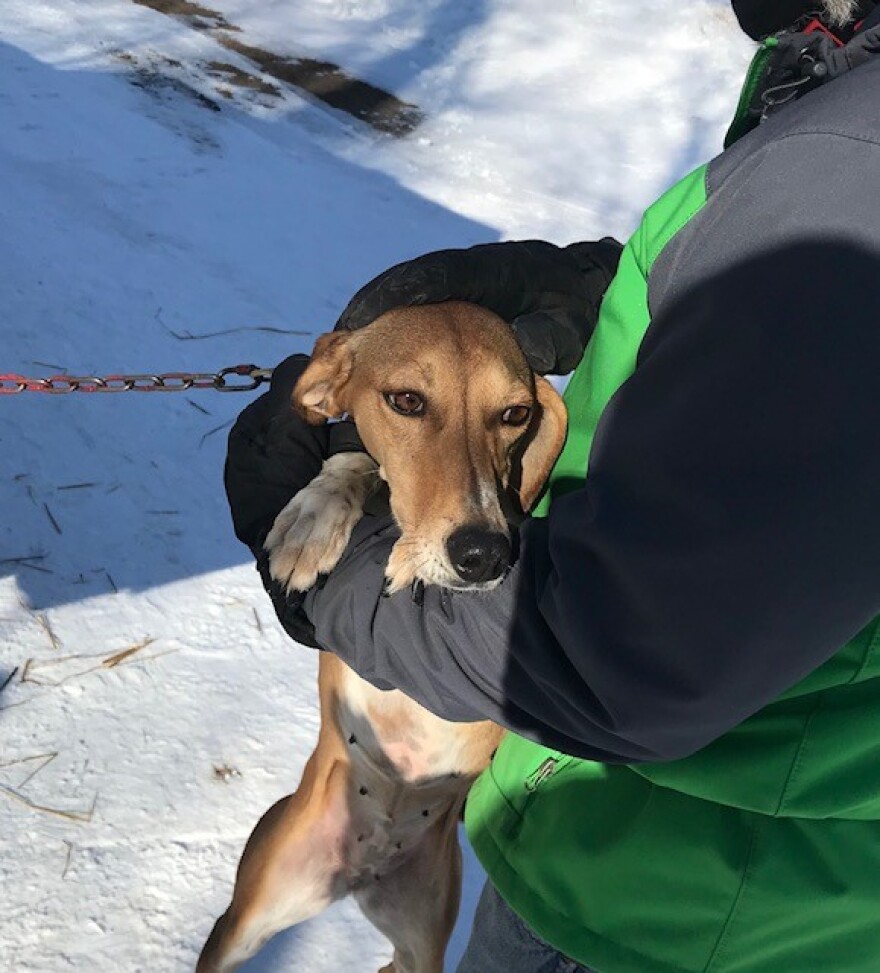Northwoods Dog Sledding
The image many have of dog sledding is a parka-wearing man pulled by Siberian Huskies slowly crossing a barren tundra. A visit with the Langlade County Sled Dog Club found that this image is not true; the sport is dominated by women, the dogs are typically not Siberian Huskies, and their sleds travel through the woods at incredible speeds.
Members of the Langlade County sled dog club meet on most Saturdays with dozens of yelping, tail-wagging dogs. They are practicing for competitive dog sled sprint races at the Crooker Hills sled dog trails, east of Antigo. For 4 to 12 miles, the dogs run as fast as they can. And these dogs can run fast.
Club President, Jamie Perry, got hooked on the sport when she was just 14 and by the time she graduated from high school she had 21 sled dogs. Today she runs a kennel and travels each weekend to practice or race with her 12-year-old daughter, who also races. Perry’s kennel is unique in that they do race with Siberian Huskies. Perry explains that today’s sport is dominated by other breeds.

“My boyfriend races and he uses hound crosses or Euro-hounds. They have been bred with English short hair pointers and German pointers and greyhounds. They don’t have much fur and they run very, very fast. They are topping 22 or 23 miles per hour.”
Most of the mushers at the trail on this bright and sunny morning are women, which is representative of the sport.
“You will see a lot of highly competitive drivers who are women…. Some of our top competitors in all aspects of the sport are women.”
Today they are running just a three-mile loop, which takes only about 15 minutes. The rest of the week is spent training and caring for their dogs.
As the harnesses are put on the dogs their excitement is evident. When they are not yelping, they are nuzzling with their handlers. Beth Castaldi gets a hug from at least a dozen dogs as we talk. She owns a nearby kennel with her husband Ken, who has been grooming the trails for years. For Beth it is a dog thing.

“Oh absolutely. 100%. It is all about the dogs. The nurturing of the dogs, the training of the dogs.”
Ken agrees that the relationship with the dogs is the best part of the sport.
“The enthusiasm of the dogs. You are one with the team. You are the trainer, the handler the feeder. It is like owning your own professional sports team, plus you are part of the team. There is really a tremendous bond with the dogs.”
There is no doubt about that as both dogs and mushers are anxious to get going as Ken provides a trail caution.

“I might warn everybody that I did see a squirrel.”
Beth and Ken have trained the dogs to ignore deer, birds, and bear. But they can’t always resist going after a squirrel. It is a reminder that they may be trained athletes, but they are still dogs.
“I have totally obliterated sleds when the dogs have gone after squirrels on these trails.”
Despite the danger, most practice runs and races go smoothly because of the close relationship between dogs and musher. Club President Jamie Perry is familiar with that relationship. She’s always been close with her dogs, so she knows that this strong relationship can also have a downside
“I guess what it comes down to is that I knowingly go into this and anytime we bring in a new dog or welcome a new set of puppies we know that we are setting ourselves up for heartache. You just hope that you give them anything they have ever wanted in life and we absolutely know in return that they have given us as athletes as friends and parts of our family.”
She lost a dog recently that she refers to as her “heart dog,” because of their especially close bond.
“It is hard. I really questioned what I was doing. At the same time, I have these puppies who were born in October and I am watching one run around our house right now. In 10-12 years, she may not be here. It is hard but we love what we do. We love dogs in general and we know how much they love what they do.”
Even though the sport has built-in heartache, Perry encourages people to get involved.
“It is a great way to bond with your dogs, exercise and enjoy time outside. And any dog can do it. We see people running anything from Corgis and Boxers to Siberians and Great Danes, and Poodles. It doesn’t matter what kind of dog. If they have a drive and want to work with you it is something that anybody can do.”
To learn more about the sport, you can visit the Langlade County Sled Dog Club website: https://www.langladecountysleddogclub.com/





